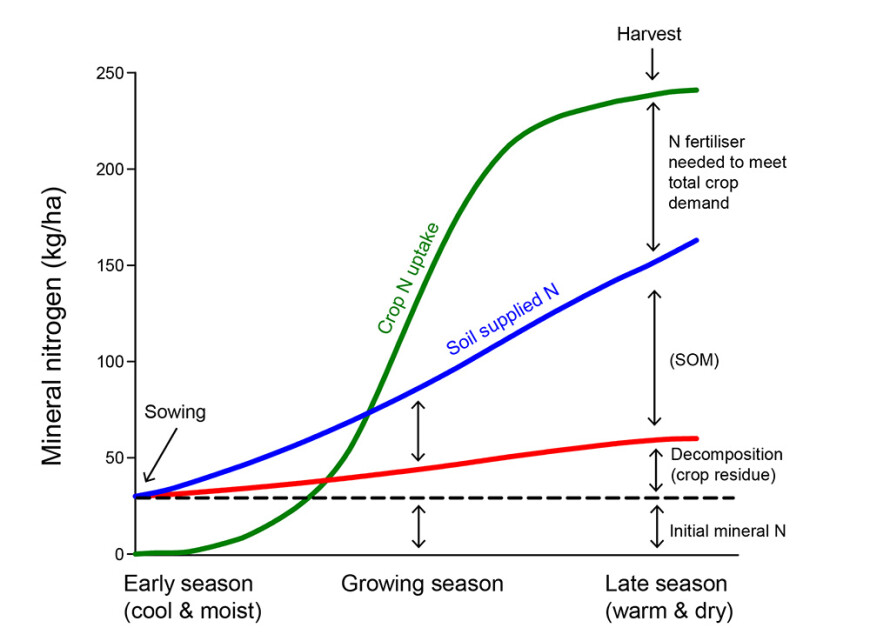Better nitrogen management: The answer lies in the soil
Total crop N demand refers to the physiological requirement of a crop for N to achieve a target yield and quality (e.g. protein content). This includes the N in harvested (e.g. grain, tubers) and non-harvested (residues, including roots) parts of the crop. The total N demand of medium- to high-yielding crops differs markedly between crop types, ranging from around 90–120 kg N/ha for spinach to 250–350 kg N/ha for feed wheat.
During crop development the N demand of most annual crops follows a sigmoidal curve that corresponds to the crop’s growth rate and the formation of vegetative and yield-forming components (see figure). Where N supply is high, some crops will take up more N than is required to meet their demand. In certain cases this excess N uptake adversely affects crop yield or quality, while in other cases it reduces the risk that excess N will be lost to the environment.
Understanding the N required to meet but not exceed the N demand of a given crop at a designated target yield (or quality) is essential to improving N management. The N demand of some crop types (e.g. feed wheat) is well known and widely applied in industry guidelines. In contrast, the N demand of other crops is poorly known or rarely used to inform N management. These latter cases are clearly a barrier to improved N management that both increases profitability and reduces the risk of N losses.
Accurately forecasting the amount of N fertiliser needed to meet crop demand depends on being able to predict the supply of mineral N from soil and crop residues (see figure). Mineralisation is a microbial process that involves the gradual breakdown of soil organic matter to release mineral N. It can contribute a large quantity of plant-available N (40–300 kg N/ha/year), which varies depending on soil type, management history, and environmental conditions. Until recently, predicting the supply of N from mineralisation was a major limitation to forecasting the additional N fertiliser needed to meet crop demand.
Predicting N mineralisation in the field requires a measure of the soil’s N mineralisation potential (i.e. the N released under ‘optimal’ conditions) and a method to forecast how much of the potential will actually be mineralised under field conditions. Recently, a simple, practical test for potentially mineralisable N (PMN) was developed by the Bioeconomy Science Institute, Plant & Food Research group, using measurements from a wide range of agricultural soils, and is now available from several commercial testing laboratories. In-field N mineralisation can be predicted by applying local climate factors to the PMN test values for the period of crop N uptake (guidelines here). In partnership with arable and vegetable growers, field trials have demonstrated that predictions of in-field N mineralisation closely match the N mineralisation measured under a wide range of annual crops.
Soil testing for mineral N and PMN at the start of the crop-growing season can be used to estimate how much N is immediately available for uptake at crop emergence and how much additional mineral N will be released by the mineralisation of soil organic matter during crop development (see figure). This allows us to estimate both the quantity and timing of soil N supply relative to the change in N demand during crop development. The difference between N supply and demand can be used to ensure that the addition of N fertiliser is sufficient but does not greatly exceed the crop’s requirements.
Where mineral N and in-field N mineralisation are known, the additional fertiliser N required to meet crop demand can be estimated as:
N fertiliser (kg/ha) = crop N demand – (mineral N + in-field N mineralisation)
This relatively simple approach assumes that any losses of N from the soil during crop development are negligible. The approach is not suitable for crops that fix nitrogen gas (N2), which tend to benefit little (if any) from the application of N fertiliser.
Building farmer confidence in using these soil N-testing and in-field prediction methods depends on demonstrating their efficacy across a wider range of soils, crops, and climates. It also depends on ensuring that the quality assurance of commercial testing is maintained and verified. Finally, incorporating soil mineral N testing alongside in-field predictions of N mineralisation (based on PMN tests) into nutrient management decision support tools (e.g. OverseerFM or the Sustainable Vegetable Systems Tool) is an important pathway to improve their adoption by farmers.

A conceptual model depicting the cumulative supply and demand for mineral nitrogen (N) over the growing season of an annual crop. SOM = soil organic matter.
Acknowledgements
This article was adapted from one soon to be published in AgScience by the New Zealand Institute of Agricultural and Horticultural Science. The research underpinning this article was funded by the New Zealand Institute for Bioeconomy Science Ltd, Plant & Food Research Group, and the Ministry for Primary Industries’ Sustainable Farming Fund project ‘Mineralisable N to improve on-farm N management’ (project number 405891).
Key contact
Mike Beare
Principal Scientist,
Bioeconomy Science Institute, Plant & Food Research Group
mike.beare@plantandfood.co.nz
